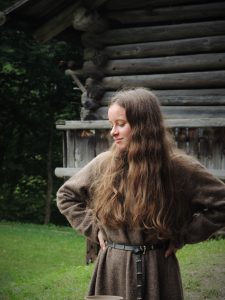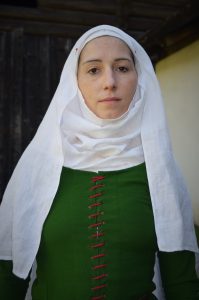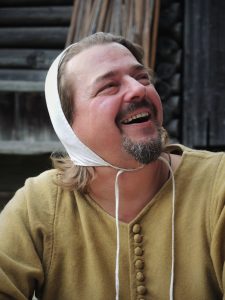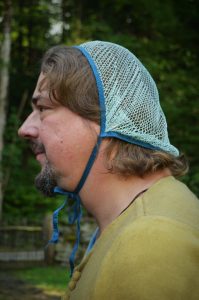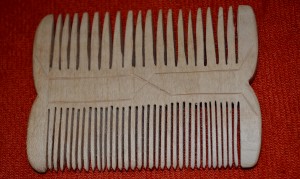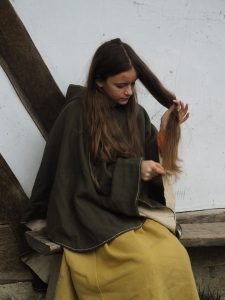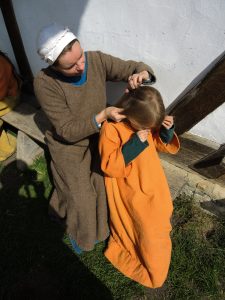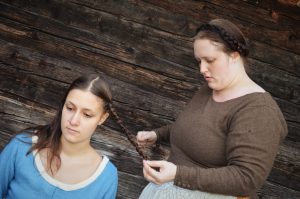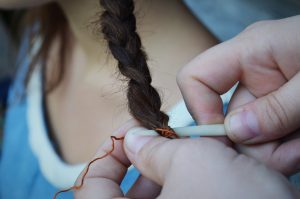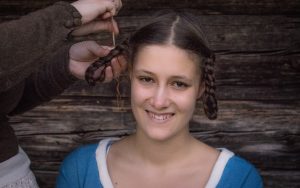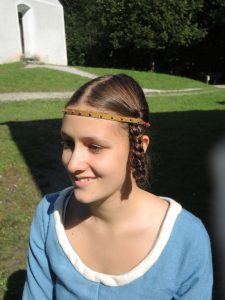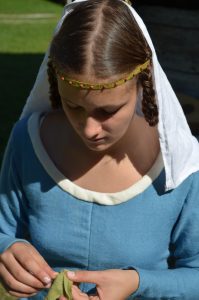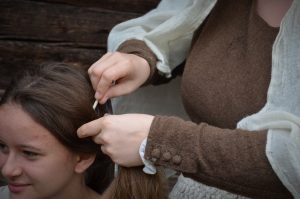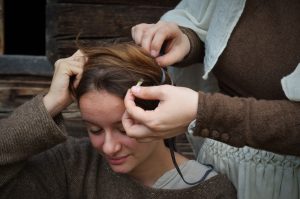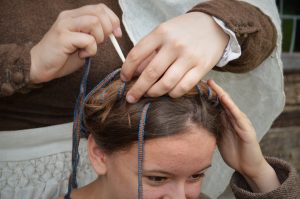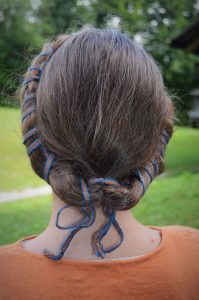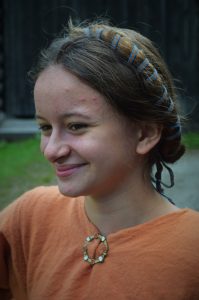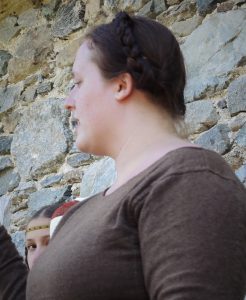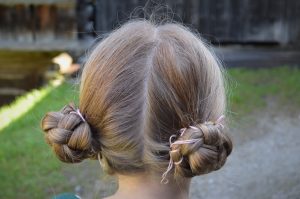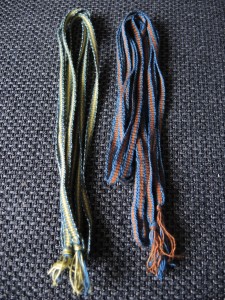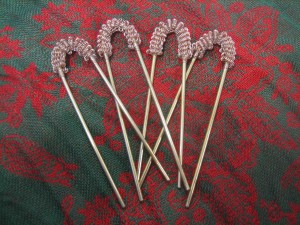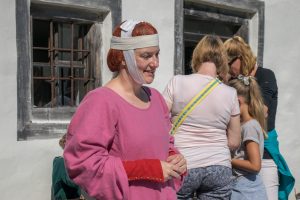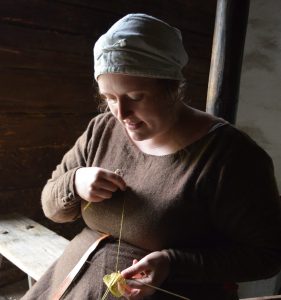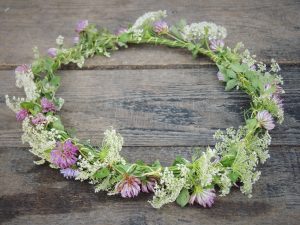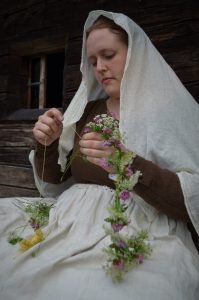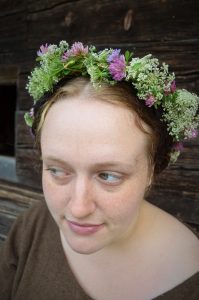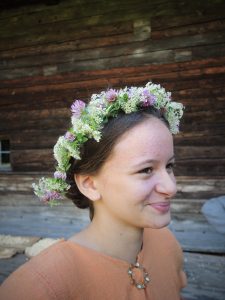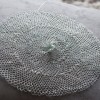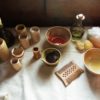Hair care and hair dos in the 14th century
On one of our events at the Museum Tiroler Bauernhöfe last weekend, I did a little lecture on hair care and hair dos as well as hair in general. I brought this to digital paper now to be able to link it in the future.
Please do follow also the links in the text to find further reading material, original sources and intersting tutorials.
Hair lengt:
On the few occasions, when we can see untamed hair of medieval women, we can see a pretty similar picture of how women cut their hair. It was long, long and long. Open hair in public is a privilege of young and unmarried women though. After the wedding or from a certain age on, it is customary to braid the hair and/or cover it with a veil. Especially the church is of course the happier, the less hair you can see.
The men wear their hair usually in chin lengt and often curled, sometimes with a pony in the front, but we occasionally also see short hair and longer hair . A hat is customary for almost all men, be it straw or felt or a coif like my colleague here or a variation of a male hairnet like the one I made for my colleague which you can see here in detail .
The beauty ideal for women was long, curly and blond hair and only clean, shiny and well groomed hair was considered beautiful.
You either had theses locks naturally or you could create them artificially.
In ‘Neidhart von Reuental’ we can read on the matter:
„Habt ir niht geschouwet sine gewunden locke lange die da hangent verre vür daz kinne hin ze tal? in der huben liegent si es nahtes mit getwange und sint in der maze sam die kramesiden val von den snueren ist ez reit innerthalp der huben vollecliche hände breit so ez beginnet struben.“
and „er hat gewunden kruse valwe locke am ende widerstürzet: daz machet im diu hube mit den snueren.“ and „sin har daz ist geringelot, des nahtes wohl gesnüeret.“
In Chaucers Canterbury tales we can read: „hair curled as though it had been pressed with irons“
The moral writer Johann Geiler tells us: „Mit schwebel, hartz, bueffen das har, darinn schleget man eyerklar das es im schueffelkorb werd krausz, der hengt den kopff zum fenster ausz. Der bleicht es an der Sonn und feuwr – pfuch schand der teutschen nation, das die natur verdeckt wil hon“
And in the ‘Ring von Wittenweiler ‘ it is written:
„Und machten sey viel schön da her mit salben von capponer smer mit pürsten und auf machen sam sitt ist ze den sachen.“
In the early 13th century, ‘Wigalois’ says the following: „hie vor do zierten die man ir lip mit zöpfen sam nu diu wip, solhes sites nu niemen gert […]ir har geflohten unde reit, mit borten wol bewunden.“
Hair washing and combing:
For grooming the hair, there was several different procedures. Between washes, it was important to thoroughly comb the hair. We have many finds of combs in this stye:
The rougher side would be used to comb out knots, afterwards the fine side is used for combing out dust and dirt and spreading the body’s own grease (the so called Sebum), over the lengths of the hair. The sebum is a natural conditioner for the hair but needs to be combed away from the scalp so it does not collect around the roots of the hair. Only if you do this thoroughly, the hair stays fresh and does not smell after a day or two.
A little excursion into growing your hair: Today, we usually wash our hair daily or every other day. If you do this from your childhood on, your scalp will adjust the production of the Sebum in order to keep the hair safe from the aggressive shampoos we use. That also means that the hair will be greasy faster and we need to wash more often. But if you keep washing to a minimum, the production will be lowered again and your hair will stay shiny and beautyful for longer periods of time. Read that up in long hair forums on the internet if you are interested in growing your hair and causing less damage to it. You can get the rhythm down to a week or two or even longer.
How often people washed their hair, we do not exactly know, but in the ‘Decamerone by Giovanni Boccacio’ (14th century Italy), one of the (higher class) protagonists says about the weekend:
“On Saturday, it is customary for us women to wash our heads and free it from dust and dirt that have collected during businesses of the week. “
And in his “Corbaccio”, Boccaccio lets a husband tell about his wife washing her hair often with differend lyes.
Washing the hair was done with thin lye, for example from burnt vine (or any other ash or natron/soda) mixed with warm water and different fragrant herbs. With lye you can do a very good hair wash that is also gentle to your hair, but you should usually do a second wash with a slightly sour liquid, f.e. Water mixed with a little vinegar, so no soap-chalks will adhere to the hair. We do not know if those sour rinses were in use. Geoffrey de la Tour Landry mentions hair washes with wine in 1484 and the Trotula mention washing with vinegar (against vermin) however, which would effectively do the same. After washing, the original sources recomment to just air dry and comb the hair.
Here you can see us washing hair after medieval sources.
Scent, shine and colour:
Naturally beautiful hair is something to aspire to in the 14th century, but of course, more is possible.
Sources describe hair powders made from cloves, galgant, nutmeg and rose petals, also rose water and musc was in use to make the hair smell nice. It was simply spread in the hair with the hands or a comb or put on the veil.
Here you can see how we made this hair powder
What many people do not know is that in medieval times, women were already able to dye their hair, brown and black with walnut shells and gallnuts, golden with safran and dyers broom and acidic liquids that bleach the hair, red with dragon blood (an oriental plant), henna or brazil wood. These mixes were spread in the hair and left there overnight or up to 3 days. You might be thinking that this can not be good for the hair and I agree, you should absolutely not leave your hair and scalp in tannic acid or dyers plans mixed with alum over days!
For shine and strength, some mixes with partly strange ingredients can be found in the sources. Most of them are either mixtures of acidic liquids that smooth the hair structure (more shine) or grease/oil based conditioners that make the hair strong and healthy.
We even have some recipes that are supposed to make hair curly, but mechanical curling like braiding the hair before sleeping will work mor reliantly.
By the way, not only women were tending to their hair a lot, also men were doing everything they could to look good, which was a thorn in the eye of different contemporary writers from the 14th century. Franz von Retz and Johannes von Capestrano (14th and 15th century) complain about the excessive hair care attempts of Viennes (male) students that used eggs, wine, quicksilver and other luxury ingredients to make their hair and beard shiny. (Oppl – Wien im Spätmittelalter)
The “Roman de la rose” also mentions different ways of adorning or faking hair: “She should have the hair of some dead woman brought to her, or pads of light-coloured sikl, and stuff it all into false hairpieces. She should wear such horns above her ears that no stag or goat or unicorn could surpass the, not though his head were to burst with the effort, and if they need color, she should dye the with many different plant-exracts, for fruit, wood, leaves, bark and roots have powerful medicinal properties.”
Vermin:
Against lice and hair mites, people were relatively powerless in comparisson to todays medical possibilities. They tried to kill them with mixes from ash and oil (oil makes the lice immobile and facilitates collecting them) and keep them away with fragrant oils and herbs (lice do not like strong smelling natural oils). But the most effective measure was still prevention.
Find more on medieval strategies agains Vermin here.
Hairdos:
We know a lot of different hair dos from medieval the 14th century. A simple braid is never wrong, maybe even in hering bone style or 2 braids to simply let them hang.
Very well known in reenactment today is this model from original pictures is this hair do , we call it „templebraids“ for lack of a better words because the most seen form of this hair do is 2 braids, braided from the temple temple down and then let them hang on the sides of the face and fold them. I fixated the hair do with thread and needle, a technique I learned from the videos of Janet Stephens and it fits very well in a time where we have neither hair needles nor rubber bands but a load of complicated updos. Sewn hair dos are very long lasting and you can even sleep on them.
Accessorised with a small headband (from tablet woven silk with coral pearls) and a veil, the result looks like this.
Very interesting for Italians and Tyroleans is this this hairdo, that can be seen in many italian original pictures and in Tacuinum Sanitatis (late 14.th century). For this I only bound the hair into a pony tail the back and then separated two large strands that I would around the head and sewed them with a needle and a silk ribbon.
You can also sleep with this for 1-2 nights.
Personally, I am a fan of the “Gretel” hairdo, so two braids that are simply fastened on the top of the head. You can see this one especially in sources for the 15th century, but there are also sources for the 14th century.
I especially loved this picture from around 1400 from Salzburg, in which the girl just knoted her braids on her forhead. I tried it and it works!
A nice hairdo that you usually find und underneath hair nets in that time are these buns or snail houses from braids. We are also working with two long braids here that we sew togehter in a spiral. It looks so cute on our youngest little lady and will hold for a day of playing outside or even longer.
Accessories:
The utensils I have for hair care and styling, I already showed you further up this article. I always carry a comb, small scissors, silk thread and a bone needle with me. In every hair set there should also be:
Ribbons from silk or wool in different lengths , a pretty headband or circlet from woven ribbons or metal, hair needles, f.e. after the london finds and a pretty hairnet from silk, which you can either wear alone or over the mentionned hair dos.
On this picture here we can possibly see a cosmetical necessaire. Could that be hair needles?
And the emergency solution for every bad hair day, a hair sack/coif.
And if you lack the required amounts of hair, medieval people had a solution for that as well.
For a festive day, the good old flower wreath always works. We see that in quite an amount of pictures.
Further reads:
On the topic of hair care and hair washing this article of mine will be interesting for you as well.
More on veils of the woman here.
My absolute recommendation for hair care and cosmetics ar the Trotula.
My Pinterest collection on this topic.
More about veils in practice
More about coifs and hair scarfs
Related Posts
The following posts might interest you as well:




